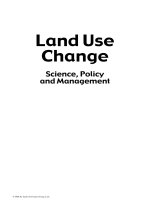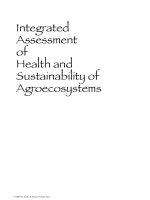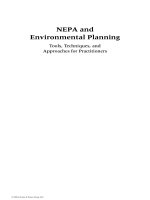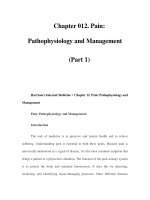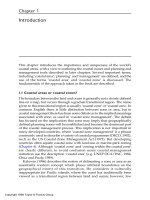Coastal Planning and Management - Chapter 1 pptx
Bạn đang xem bản rút gọn của tài liệu. Xem và tải ngay bản đầy đủ của tài liệu tại đây (547.89 KB, 17 trang )
Chapter 1
Introduction
This chapter introduces the importance and uniqueness of the world’s
coastal areas, with a view to outlining the coastal issues and planning and
management tools described in later chapters. Several important terms,
including ‘coastal area’, ‘planning’ and ‘management’ are defined, and the
use of the terms ‘coastal area’ and ‘coastal zone’ is discussed. The
fundamentals of the approach taken in the book are described.
1.1 Coastal areas or coastal zones?
The boundary between the land and ocean is generally not a clearly defined
line on a map, but occurs through a gradual transitional region. The name
given to this transitional region is usually ‘coastal zone’ or ‘coastal area’. In
common English there is little distinction between zone or area, but in
coastal management there has been some debate as to the implied meanings
associated with zone, as used in ‘coastal zone management’. The debate
has focused on the implication that zone may imply that geographically
defined planning zones will be established and become the dominant part
of the coastal management process. This implication is not important in
many developed countries, where ‘coastal zone management’ is a phrase
commonly used to describe a variety of coastal programmes (OECD, 1992),
such as the US Coastal Zone Management Act (1972). But developing
countries often equate coastal zone with land-use or marine-park zoning
(Chapter 4). Although ‘coastal zone’ and ‘zoning within the coastal zone’
are clearly different, to avoid confusion many coastal management
initiatives use the description ‘coastal area’ (e.g. UNEP OCA/PAC, 1982;
Chua and Pauly, 1989).
Kaluwin (1996) describes the notion of delineating a zone or area as an
essentially western concept which places artificial boundaries on the
geographical extent of this transition. He considers it culturally
inappropriate for Pacific islands, where the coast has traditionally been
viewed as a transitional region between land and ocean; however, few
Copyright 1999 Taylor & Francis Group
coastal nations, especially in developed countries, take this enlightened
traditional Pacific view of the coast. In this book we concur with Kaluwin
(1996) that zone could be implied to mean a planning zone, and to ensure
consistency we use coastal area or simply ‘at the coast’ or ‘on the coast’,
except when quoting from original sources which use the term coastal zone.
1.2 Defining the coastal area
Defining the boundaries of a coastal area is of more than academic interest
to coastal planners and managers. Governments often create administrative
systems, or set out policies to guide decision-making, that operate within a
defined coastal policy area. The variety of ways in which such areas may
be delineated in order to serve the purposes of particular policies are
outlined in this section.
1.2.1 Scientific definitions of a coastal area
The coast is where land and ocean meet. If this line of meeting did not
move, defining the coast would be easy—it would simply be a line on the
map—but the natural processes that shape the coast are highly dynamic,
varying in both space and time. Thus the line that joins land and ocean is
constantly moving, with the rise and fall of tides and the passing of storms,
creating a region of interaction between land and sea.
There are parts of the coastal environment that clearly have strong
interactions between land and ocean, including beaches, coastal marshes,
mangroves and fringing coral reefs; other parts may be more distant from
the immediate coast (inland or out to sea) but they nevertheless play an
important role in shaping it. One of the most important of these is the
rivers that bring freshwater and sediment to the coastal environment. In
this case, the inland limit to the coast is catchment boundaries that can be
thousands of kilometres inland at the head of catchments. For example,
the Ganges-Brahmaputra river system whose sediments form much of
Bangladesh rises far inland in the Himalayas.
Therefore, the coast may be thought of as the area that shows a connection
between land and ocean, and a coastal area defined (Ketchum, 1972) as:
the band of dry land and adjacent ocean space (water and submerged
land) in which terrestrial processes and land uses directly affect
oceanic processes and uses, and vice versa.
The key element of Ketchum’s definition is the interaction between oceanic
and terrestrial processes and uses: coastal areas contain land which interacts
with the ocean in some way, and ocean space which interacts with the
land. Thus coastal areas:
Copyright 1999 Taylor & Francis Group
• contain both land and ocean components;
• have land and ocean boundaries that are determined by the degree of
influence of the land on the ocean and the ocean on the land; and
• are not of uniform width, depth, or height.
The three above elements are depicted in Figure 1.1, which shows, for a
sandy beach coast, the strength of interaction between coastal and ocean
processes and uses, termed here the ‘degree of coastalness’, against the
distance away from the immediate coast. Figure 1.1 could be repeated for
other coastal environments, such as delta coasts, beach/barrier systems
and estuarine coasts, where the various physical and biological processes
of these environments will determine the ‘degrees of coastalness’. On deltaic
coasts, for example, important determining factors would be the degree of
salt water penetration in to fresh surface- and groundwater systems, and
the seaward distance to which sediments of terrestrial origin are moved.
As Figure 1.1 shows, the transition between land and ocean is often
gradual, depending on local biophysical conditions. The issue here is not
Figure 1.1 Example of ‘degrees of coastalness’ for a sandy beach coast.
Copyright 1999 Taylor & Francis Group
the nature of the actual transition, but what its implications are for defining
a coastal area. Choosing the thresholds which define the landward and
seaward limits of a coastal area depends to a large extent on why the
definition is needed. This ‘need-driven’ approach to coastal area definition
is discussed further in the next section.
1.2.2 Policy oriented definitions of a coastal area
In practice, the [coastal] zone [area] may include a narrowly defined
area about the land-sea interface of the order of a few hundreds of
metres to a few kilometres, or extend from the inland reaches of coastal
watersheds to the limits of national jurisdiction in the offshore. Its
definition will depend on the particular set of issues and geographic
factors which are relevant to each stretch of coast.
(Hildebrand and Norrena, 1992)
Coastal zone [area] management involves the continuous
management of the use of coastal lands and waters and their resources
within some designated area, the boundaries of which are usually
politically determined by legislation or by executive order.
(Jones and Westmacott, 1993)
At a policy level the limits of coastal areas have been defined in four possible
ways:
• fixed distance definitions;
• variable distance definitions;
• definition according to use; or
• hybrid definitions.
Current or proposed examples of each of the above definitions are given in
Appendix A.
Fixed distance definitions, as the name implies, specify a fixed distance
away from the coast which is considered ‘coastal’. Usually this distance is
calculated from some measure of the boundary between land and water at
the coast, usually the high water mark. Fixed distances defined for the
ocean component of a coastal area usually apply to the limit of
governmental jurisdiction, for example the limits of Territorial Seas. An
example of a fixed definition coastal area as used by the government of Sri
Lanka is shown in Figure 1.2.
As for fixed distance definitions of coastal areas, the boundaries of
variable distance definitions are set from some measure of the coast, usually
the high water mark. However, their boundaries are not fixed, but vary
along the coast according to a range of variables such as:
Copyright 1999 Taylor & Francis Group
• physical features—e.g. the landward limit of Holocene dunes, or the
seaward limit of submarine platforms;
• biological features—e.g. the landward limit of a coastal vegetation
complex, or the seaward limit of a fringing reef; and
• administrative boundaries—e.g. the landward limit of local
municipalities which front the ocean.
International organizations and large coastal nations often define the limits
of a coastal area according to the particular coastal management issue being
addressed; that is, the coastal area is defined according to the use to which
that definition will be put, and the form of definition is termed ‘definition
according to use’. For example, tackling the issue of non-point sources of
marine pollution would require the definition of an area of attention that
included inland catchments and groundwater outflow regions. A coastal
area defined for this purpose would be much larger than one defined to
manage four-wheel-drive vehicle damage of beaches and dunes. As
recognized by the Coastal Committee of New South Wales (1994, p.22):
Figure 1.2 The coastal zone of Sri Lanka, as defined by the Sri Lankan Coast Conservation
Act (Coast Conservation Department, 1996).
Copyright 1999 Taylor & Francis Group
To a large extent, the definition of the coastal zone depends upon the
purpose for which the definition is intended. From both management
and scientific viewpoints, the extent of the coastal zone will vary
according to the nature of the management issue.
Within the context of defining a coastal area according to what the purpose
is, the concept of ‘areal foci’ used by Jones and Westmacott (1993) is useful.
Areal foci include:
• an administratively designated area, in the sense that the political process
or the administration will designate the responsibility to manage;
• an ecosystem area;
• a resource base area, e.g. a mineral body, oil fields, fisheries, habitats,
etc.; and
• a demand area, i.e. the wider area from which demands are exerted on
the designated coastal area, such as for use for recreation, marine
transport or waste disposal.
Defining a coastal area according to use has the advantage of focusing
attention on particular issues. However, care needs to be taken to avoid
multiple coastal area definitions being established in one region to
address different coastal management issues, leading to confusion.
Defining the coast according to one use only may perpetuate sectoral
managerial systems and detract from an integrated management
perspective.
Hybrid definitions mix one type of coastal definition for the landward
limit of the coastal area and another for the seaward limit. This is relatively
common practice by governments that have a fixed limit of jurisdiction
over nearshore waters. Australian States, for example, have management
responsibilities for coastal waters 3 nautical miles from the coastline. Some
Australian State governments use this to define the seaward limit of their
coastal areas, while choosing other means to define the landward
boundary (see Appendix A). For example, the recent definitions of coastal
areas adopted by the Queensland State Government are shown in Box
1.1.
The vertical dimension of any coastal area definition can also be included;
that is, the depth below the surface and height above a coastal area
considered to be covered by a coastal policy. Usually the vertical dimension
is part of the overall legislative framework of governments, and is not
explicitly covered by coast-specific policies. Examples include all mineral
rights below coastal lands and waters and the atmosphere above it, which
are generally covered by laws and regulations that cover all other parts of
a government’s jurisdiction.
Copyright 1999 Taylor & Francis Group
Box 1.1
Coastal definitions used in the Queensland
Coastal Protection and Management Act (1995)
• Foreshore means the land lying between high water mark and low water
mark as is ordinarily covered and uncovered by the flow and ebb of the
tide at spring tides.
• The coast is all areas within or neighbouring the foreshore.
• Coastal management includes the protection, conservation, rehabilitation,
management and ecologically sustainable development of the coastal
zone.
• Coastal resources means the natural and cultural resources of the coastal
zone.
• Coastal waters are Queensland waters to the limit of the highest
astronomical tide.
• Coastal wetlands include tidal wetlands, estuaries, salt marshes, melaleuca
swamps (and any other coastal swamps), mangrove areas, marshes, lakes
or minor coastal streams regardless of whether they are of a saline,
freshwater or brackish nature.
• The coastal zone is:
(a) coastal waters; and
(b) all areas to the landward side of the coastal waters in which there are
physical features, ecological or natural processes or human activities that
affect, or potentially affect, the coast or coastal resources.
In summary, a generic definition of coastal areas is not proposed here.
Rather, a pragmatic view of defining a coastal area is taken, where the
definition reflects the use or uses to which it will be put. If the purpose is to
control certain types of development, then fixed, variable or hybrid
definitions may be used. If reducing pollution of marine waters is the
purpose, then variable definitions including catchment or groundwater
boundaries may be more appropriate. By focusing on coastal management
issues, and not on problems of definition, simple and workable definitions
of coastal areas usually follow.
1.3 The unique characteristics of coastal areas
Stating that the coast is unique because it is where land and oceans meet
may appear rather obvious, but it is a fact of great significance. The contrast
between land and ocean may be dramatic where ocean swells crash against
rock cliffs, or more gradual where tides ebb and flow over marshes. It is
this interaction between marine and terrestrial environments that makes
the coast unique—and uniquely challenging to manage.
Copyright 1999 Taylor & Francis Group
The transition between land and ocean at the coast produces diverse
and productive ecosystems which have historically been of great value to
human populations. Use of the coast for its resources has long been
combined with its value as a base for trading between countries, both across
oceans and by the rivers which flow out to sea. Coastal lands and nearshore
marine waters have consequently long been at a premium. As populations
grow and increase their level of socio-economic development, this premium
also grows. The consequence of this intense and long-standing pressure on
coastal resources is that problems with the way in which competing uses
are managed within a country as a whole tend to become manifest first on
the coast.
To make management even more difficult, major administrative
boundaries commonly follow high or low water lines, bisecting coastal
areas and dividing the management of the land from that of the ocean.
Coastal land is usually owned and/or managed by a multiplicity of
private, communal, corporate and government bodies, whereas coastal
waters are usually owned and/or managed solely by governments.
Furthermore, administrative boundaries can follow the centres of rivers
and estuaries, dividing their management between two neighbouring
authorities.
The uniqueness of the coast is further enhanced by the value of its
resources such as fish and offshore mineral reserves, which are considered
by the populace to be common property, and in high demand by coastal
dwellers for subsistence use, recreation and economic development (Berkes,
1989; Feeny et al., 1990). Exploitation of such resources raises their value,
with a consequential demand for equitable resource allocation. Therefore,
resource planning often forms an integral part of coastal management
programmes.
1.4 A brief history of coastal management and planning
A brief history of the development of coastal area management and
planning is presented for two main reasons. First, history provides a
framework for understanding how current approaches to the planning and
management of coastal resources have evolved, and the constraints these
approaches are operating within. Second, by looking back at how coastal
planning and management have developed, trends become evident.
Projecting such trends provides an insight into the possible future
development of coastal management and planning.
Humans have deliberately modified the coastal environment and
exploited its resources for thousands of years. Ancient civilizations
throughout the world built ports and seawalls, or diverted river water
flowing into the sea; they also evolved various management systems for
their fisheries, use of rich coastal soils for agriculture, trading through ports,
Copyright 1999 Taylor & Francis Group
and other coastal resources. Examples include: ancient Greek and Roman
port cities throughout the Mediterranean; the diversion of the Yangtze
(Yellow) River, China in AD1128 (Ren, 1992); and the reclamation of
mangrove areas over 1000 years ago on Pohnpei, Federated States of
Micronesia (Sherwood and Howarth, 1996).
Ancient interventions such as these in the coastal environment were all
works of civil engineering. That is, structures were built to modify the flow
of water and/or sediment. Given that such structures were all essentially
hand built, the scale and intensity of their impacts on the coastal
environment were limited, but over the centuries the ability of humans to
influence coastal processes increased as construction techniques improved.
Perhaps the most famous example of diversion of water courses and
construction on the coast was the building and maintenance of the current
urban form of Venice, Italy, from the seventh century AD (Frassetto, 1989).
For these civilizations an informal form of resource planning was undertaken
either by community consensus or by a leader who decided when, where,
how and how much resources would be exploited. Resources were abundant
but sparsely exploited because of limited technology. Hence resources were
generally allocated on a social rather than on an economic basis.
Technological limitations were dramatically reduced as a result of the
industrial revolution, which started in Europe in the mid-nineteenth
century. The industrial revolution brought machines that could be used to
construct grander civil engineering works. Major modifications of the
coastal environment were now possible: large rivers could be dammed or
diverted and vast areas of coastal wetlands could be converted to urban or
agricultural land.
The industrial revolution also altered the community’s view of its
resources. Viewing them as tangible elements or objects of nature led to
the use of the term ‘natural resources’, and management, including
planning, now focused on supply and demand, and the options for
managing these factors. This was linked to the pervasive western cultural
attitude at the time of human dominance over other animals and natural
systems.
Concentrating on economic factors, very little attention was given to
the ecology (including habitats), social demands or public perceptions
(O’Riordan and Vellinga, 1993). The underlying objective was to maximize
profits, which usually translated into maximizing production. The weakness
of this approach was the assumption that resources are easily valued, single
purpose and static in value over time, which we now know is not valid
(Chapter 4).
During the industrial age the market place began to dominate resource
allocation, while social norms no longer guided resource use. Resources
were perceived as limitless and there to be consumed for profit (Goldin
and Winters, 1995; Grigalunas and Congar, 1995). It was not until late last
Copyright 1999 Taylor & Francis Group
century that this view began to change. Resources came to be considered
finite, a change in attitude attributable to:
• advances in economic theories on supply and demand;
• the developing realization that society had the ability to destroy the
environment, ultimately affecting its survival;
• social reforms; and
• studied attempts to plan for resource management.
In contrast, deliberate human intervention in the coastal environment to
preserve components of its natural character or ecological integrity is a
much more recent activity. Coastal ecological management grew from the
national park movement of the late nineteenth century. During this era,
protected areas or parks were perceived as places of significant scenic or
natural value set aside for the enjoyment of visitors or for scientific pursuits
(MacEwen and MacEwen, 1982). The first such parks in coastal marine
areas were established in the 1930s. Since then, protected areas with
significant coastal components have been established throughout the world,
with most being terrestrial. Currently there are approximately 4500
recognized protected areas (as defined by the IUCN) around the world, of
which only about 850 include a coastal or marine component (Elder, 1993).
Expansion of land use planning in the late nineteenth and early twentieth
centuries also influenced coastal area management in developed and
colonial ‘new world’ countries (Platt, 1991). Important influences included
the notion of separating conflicting land uses through zoning, planning
open space areas for the public good and health, and sanitation problems
which affected waste disposal into coastal waters. While the main way to
effect such interventions was through the use of the engineering works
described above, it is the role of land use planners in directing the expansion
of urban environments into coastal areas, and their enthusiasm for
embracing engineering interventions, that is important here. Urban
expansion brought with it the need to develop the coast for new residential
areas and industries, as well as a need to cater for increased recreational
use of the coast.
Different streams of human endeavours in coastal areas, such as
ecological management, resource management, engineering intervention
and urban/industrial development, operated relatively independently for
many years. The coastlines of developed nations had been planned and
managed using land use planning and environmental management
techniques which had evolved within their various governmental and cultural
settings. Each can be considered as a form of coastal area management,
and their proponents as coastal managers. However, it was not until
Copyright 1999 Taylor & Francis Group
the 1960s and 1970s that these, and other disciplines, were brought together
under the banner of ‘coastal zone management’, a phrase credited to those
involved in the development of the US Coastal Zone Management Act in
the late 1960s and early 1970s (Godschalk, 1992; Sorensen, 1997).
Realization around the world that environments were being continually
degraded by a rapidly expanding human population led to the concept of
sustainable development in the late 1980s and early 1990s. The basis of
sustainable development is ‘development that meets the needs of the
present without compromising the ability of future generations to meet
their own needs’ (World Commission on Environment and Development,
1987), a concept now central to most coastal management efforts worldwide,
as will be shown in Chapter 3. Given the importance of sustainability
principles in coastal management, the topic is discussed further in the next
section.
Today, it is generally accepted that coastal resources can only be
effectively evaluated and managed in the total context of the social and
cultural environment (e.g. Ehler, 1995). Hence, effective resource planning
provides for decision making which allocates resources over space and
time according to the needs, aspirations and desires of society, taking into
Table 1.1 Phases in the development of coastal management (adapted from O’Riordan and
Vellinga, 1993)
Copyright 1999 Taylor & Francis Group
account society’s ability to exploit resources, its social and political
institutions, and its legal and administrative arrangements.
O’Riordan and Vellinga (1993), in reviewing the history of coastal area
management, as outlined above, summarized into four phases its
development over the past 40 years as a professional activity (Table 1.1).
1.4.1 Sustainability—the dominant paridigm in coastal planning
and management
Sustainable development requires a broader view of both economics
and ecology than most practitioners in either discipline are prepared
to admit, together with a political commitment to ensure that
development is ‘sustainable’.
(Redclift, 1987, p. 33)
Sustainability has emerged as the dominant paradigm of the world’s coastal
management programmes in the late twentieth century. The historical
context of this emergence is described in the previous section; here we
describe the concept of Sustainability and discuss its influence on coastal
programmes, from broad scale strategic planning to day-to-day
management regimes. This discussion forms the basis for the more detailed
treatment in Chapters 3, 4 and 5 of tools and techniques to help to achieve
the sustainable development of coastal areas.
The concept of Sustainability came into prominence with the publication
of the World Commission on Environment and Development (WCED)
report called Our Common Future (World Commission on Environment and
Development, 1987). The WCED group was chaired by Gro Harlem
Brundtland, hence the report came to be known as the Bruntland Report.
The message of the Brundtland Report (WCED, 1987, p. 8) was that:
it is possible to achieve a path of economic development for the global
economy ‘which meets the needs of the present generation without
compromising the chances of future generations to meet their own
needs’.
A central precept of Sustainability, to quote Pearce et al. (1989, p. xiv), is
that sustainable development leaves ‘future generations a wealth inheri-
tance—a stock of knowledge and understanding, a stock of technology, a
stock of man-made capital, and a stock of environmental assets—no less
than that inherited by the current generation’. Young (1992) recognizes a
number of themes underlying the Sustainability concept, summarized by
his ‘three Es’:
Copyright 1999 Taylor & Francis Group
• environmental integrity;
• economic efficiency; and
• equity, defined to include present and future generations and recognize
cultural as well as economic considerations.
Though precise definitions of sustainability may be rather elusive, it is
clearly not a set of prescriptive actions; rather it is the basis for a fundamental
reassessment of the way in which resource, environment, social and equity
issues are considered in decision making. The profoundness of its
implications has caused sustainability to be compared with such basic
societal values as freedom, justice and democracy (Buckingham-Hatfield
and Evans, 1996a). Seen in this light, sustainability becomes a ‘way of
thinking’, helping to modify the context to which it is applied (Turner, 1991).
Thus, sustainability principles can ‘highlight unsustainable systems and
resource management practices’ (Turner, 1991, p. 209). The tests of
sustainability having been applied and unsustainable practices revealed,
the way opens for new, sustainable management approaches to coastal
area management to be devised and adopted (Figure 1.3).
As a ‘way of thinking’, sustainability has not only become part of the
mainstream of decision-making processes; it has also in many nations
become a political reality (Buckingham-Hatfield and Evans, 1996a)—
though remaining elusive in many others (Kirkby et al., 1991). However,
the idea that the present generation can through the application of
sustainability principles act as stewards of the earth for future generations
is as much an act of faith as it is one based on technical or scientific evidence
Figure 1.3 Sustainable and unsustainable approaches to coastal resource use (Dutton and
Hotta, 1994).
Copyright 1999 Taylor & Francis Group
(Buckingham-Hatfield and Evans, 1996a). This raises two important issues:
the weight to be given to technical information, and the time-dependence
of decision making.
Sustainability has acted as the catalyst for a new mix in the information
sources on which decisions are based. It has seen the ‘hard science’ emphasis
of the 1970s and 1980s evolve into a more balanced appreciation of scientific
and non-scientific inputs into decisions. This balancing has manifested itself
in various ways—for example, the Best Practicable Environmental Option
system in the United Kingdom (Gerrard, 1995)— but its most pervasive
expression is the ‘precautionary principle’ (Cameron, 1991), commonly
defined in the language of Principle 15 of the Rio Declaration (UNCED,
1992):
In order to protect the environment, the precautionary approach shall
be widely accepted by the States according to their capabilities. Where
there are threats of serious or irreversible damage, lack of full scientific
certainty shall not be used as a reason for postponing cost effective
measures to prevent environmental degradation.
This principle is now incorporated into the London and Hague Declara-
tions dealing with marine pollution.
Precautionary action has three central components. First, there is an
economic dimension of cost-effectiveness; second, decisions which may
have irreversible impacts, so providing a legacy for future generations, gain
heightened importance in the decision-making process; and third, the lack
of a requirement for complete scientific information in the face of
economically inefficient and/or irreversible impacts—a substantial shift
from a rational-comprehensive view of decision making, as will be shown
in Chapter 3. It is important to note that a precautionary approach to guiding
decision making is a very recent phenomenon and its use is not uniform
around the world (O’Riordan and Cameron, 1994). However, its current
use in some coastal nations, and probable spread to many more, is likely to
see precaution entering the lexicon of most coastal managers in the next
few years.
A central part of the ‘way of thinking’ introduced in this section is the
consideration of time dependence in decision making; that is, consideration
of the effects of present-day activities on future generations (Young, 1992).
Sustainability thinking requires that future effects and impacts of decisions,
and not simply those in the present day, be considered. Relating to this
concept, many planners have seized upon Sustainability with the notion
that planning and Sustainability principles are similar, and that a
convergence of planning and sustainable development is emerging under
the banner of environmental planning (Blowers, 1993; van Lier et al., 1994;
Buckingham-Hatfield and Evans, 1996b).
Copyright 1999 Taylor & Francis Group
Having looked at the general principles of sustainablity, three specific
effects of sustainable thinking on coastal management can now be briefly
considered. The first is the effect on the use of economics and economic
instruments in decision making. Environmental economics, as we shall
demonstrate in Chapter 4, is rapidly becoming one of the mainstays of the
practical use of sustainable development in decision making. Sustainability
has provided many economists with a basis for implicitly including equity,
environmental considerations and a long-term view into the cost-benefit
and other economic analyses (Jacobs, 1991). Likewise, sustainability has
also allowed environmental issues, such as conservation of biodiversity, to
become a central part of decision making, especially in those areas
previously the exclusive domain of economists—most notably economic
development. Finally, sustainable development explicitly recognizes the
quality of human life of both current and future generations. Thus, social
and cultural equity is recognized as an equal partner with economic and
environmental considerations.
In summary, sustainable development principles have had four main
effects on the way the coast is managed: one general and three specific.
The general effect is the influence ‘sustainability thinking’ has on the overall
decision-making context. The mixture of equity, environmental and
economic concepts moves the decision-making paradigm away from
considering economic and environmental decisions in isolation from each
other. The three specific impacts are in the fields of economics,
environmental resource management and social and cultural development,
summarized by Reid (1995) as requiring the following characteristics:
• integration of conservation and development;
• satisfaction of basic human needs;
• opportunities to fulfil other non-material human needs;
• progess towards equity and social justice;
• respect and support for cultural diversity;
• provision for social self-determination and the nurturing of self-reliance;
and
• maintenance of ecological integrity.
Clearly, these are major issues which go to the heart of the human cultural,
spiritual and developmental aspirations as well as fundamental issues of
governance, democracy and the relationship of humans and the
environment. They are weighty issues but, nevertheless, ones which must
be confonted to ensure a viable future for the world’s coastal regions.
Sustainablity, then, is ‘not just about managing and allocating natural
capital. It is also about deciding who has the power both to do this and to
institute whatever social, economic and political reforms are considered
necessary’ (Reid, 1995, p. 231). Any discussion of approaches to the
Copyright 1999 Taylor & Francis Group
sustainable development of coastal areas must, as a result, analyse
techniques for environmental management, systems of governance and
the role of individuals in decision making and planning processes. It is the
interplay between these factors, which is explored at length in the coming
chapters.
1.5 Summary
Coastal management programmes have generally developed in response
to problems experienced in the use and allocation of coastal resources.
Development of a coastal programme usually follows a period of mount-
ing public, political and scientific pressure on governments to tackle
problems, usually resulting in a time lag between the identification of
problems and the development of responses. Development of the US
Coastal Zone Management Act in 1972, for example, followed a period of
intense pressure for improvement in coastal land and water management
which started more than 12 years earlier (Godschalk, 1992). A similar pattern
was followed in the United Kingdom during the late 1980s to the early
1990s (King and Bridge, 1994). Much of the history of coastal management
and planning illustrates similar reactions to problems experienced in coastal
regions. Many other national and international initiatives can be traced to
the time when the problems could no longer be ignored.
A further stimulus to the development of coastal programmes was the
realization that coastal area management programmes could be used to
avoid future problems. However, unlike the development of programmes
which respond to existing problems, it is unclear when this proactive
approach became important. It may be inferred that there were some
important forward-looking parts of the US Coastal Zone Management Act;
this is not formally reflected in its aims (Godschalk, 1992). Proactive
management, through the use of various coastal planning approaches, is
now one of the most important components of coastal area management
around the world, with modern programmes blending proactive and
reactive elements to address current problems, such as ecosystem
degradation, and to avoid future problems.
It is worth re-emphasizing at this point that the deliberate actions of
humans to influence the natural processes of the coast have been occurring
for thousands of years. Coastal management choices made during this time
reflected the cultural and spiritual relationship between people and the
coastal environment. Historically, it is the perception of how the coast
should be managed, and for what purpose coastal resources will be used,
that has shaped management of coastal areas. These perceptions are
culturally and politically influenced; they have clearly changed over time,
will continue to change, and are demonstrably different around the world.
Copyright 1999 Taylor & Francis Group
The diversity of coastal area management approaches reflects these
differences.
The documented development of coastal planning and management
described above is largely a history of western nations, or those countries
colonized by western nations. In this group of nations, the evolution of
coastal programmes, as they reflect changes in cultural values, have been
well described (Table 1.1). In contrast, the traditional coastal management
systems of indigenous cultures in other parts of the world are relatively
poorly documented. Although culturally appropriate coastal management
programmes are making something of a resurgence in many developing
countries (Chapter 3), there remains much to be done in understanding
how these traditional practices evolved and how they have been extended
into the modern age. This is especially so since their integration with
western management practices is becoming increasingly important with
the pervasive spread of western technologies and management approaches.
These are recurring themes of the following chapters.
In summary, the early development of coastal area planning and
management programmes in the early 1960s and 1970s was generally in
response to urgent problems on the coast. As these reactive coastal
programmes became more established, they gradually evolved into a
combination of reactive and proactive programmes during the 1980s and
1990s. This evolution may reflect the heightened influence of planning on
the management process, or it may reflect the need to manage existing
problems by addressing possible future pressures. However, perhaps the
key lesson to be drawn from this brief history is the need to combine present
and future perspectives; that is, attempting to address present-day problems
whilst preventing new ones, an aim which fits well within the techniques
described in Chapters 3, 4 and 5.
Copyright 1999 Taylor & Francis Group

